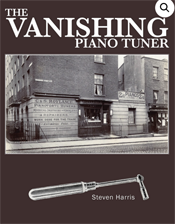Matthew James Richards ATCL, LTCL, MABPT, PTA - is a certified Piano Tuner Technician and offers services to clients covering all areas of Wolverhampton and the West Midlands. A certified member of the PTA and ABPT the leading associations of Piano tuners in the UK. He is DBS certified (formerly CRB) - Disclosure and Barring Service - suitable for schools, care homes etc.
Matthew performs a high quality standard of service throughout his work, tuning pianos for private homes, schools, churchws, oncerts, theatres, recording studios and more. He is a professional pianist (ATCL and LTCL Diplomas for the Trinity college of London) and has an extensive knowledge of the instrument.
Matthew also specialises in Nostalgia entertainment, and has played background music for the Mayor of Hereford, also for special evebts (such as Valentines Day, mother's Day etc) at local restaurants. He has also performed at the Royal Albert Hall in front of the queen for her 92nd birthday.
Mr M J Richards provides the following services:
• Tuning in Homes, Schools, Churches, Theatres and Concerts Venues
• Minor on site repairs
• Replacement broken strings
• Advice on purchasing a new or second-hand piano
• Piano Life Saver Installer




